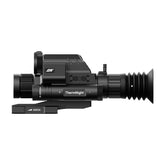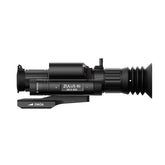Hydra vs. ThermNight: Choosing the Right Digital Optic for Your Needs

When it comes to digital optics for hunting and target shooting, selecting the right tool for the job is essential. Two of the most popular options on the market today are the Hydra and the ThermNight series, each offering unique advantages tailored to different hunting and shooting scenarios. This article breaks down their key features, similarities, and differences to help you decide which one fits your needs best.
Key Similarities: Thermal Imaging and Advanced Recording
Both the Hydra and ThermNight optics are built with a 640x512 thermal sensor, offering crisp and clear imaging for hunters operating in low-light or nighttime environments. Each model provides a 1.5-6X magnification range, ensuring effective target acquisition at various distances.
A standout feature in both models is recoil-activated recording, which automatically captures the moments just before and after a shot is fired. This allows users to review and analyze their shots without needing to manually start recording—an excellent tool for tracking, training, and post-hunt analysis.
Where They Differ: Use Cases and Unique Features
Hydra: The Versatile Clip-On and Scanner

The Hydra is designed for maximum adaptability, making it ideal for hunters who already have a preferred optic but want to add thermal capabilities. Its compact form allows it to be used as a clip-on device in front of an LPVO (Low Power Variable Optic) or a reflex sight, providing a seamless transition between standard and thermal imaging.

Another key benefit of the Hydra is its super resolution digital image enhancement. This technology improves image clarity when magnified, mitigating the pixelation that often occurs with digital zoom. As a result, hunters can identify targets more effectively at greater distances.
Additionally, the Hydra’s small footprint makes it an excellent handheld thermal scanner. Whether stored in a pocket or used with a quick-detach mount, it offers flexibility for spotting game without always needing to point a firearm at a target.
ThermNight: The All-in-One Solution

For those seeking a self-contained thermal and night vision system, the ThermNight series delivers a complete package. Unlike the Hydra, this unit combines a thermal scope with a day/night digital optic, allowing hunters to operate seamlessly in different lighting conditions without switching devices.
One of its standout features is the integrated laser rangefinder, which works in conjunction with an onboard ballistic calculator. Once the range is measured, the scope automatically adjusts for bullet drop, displaying precise holdovers or even adjusting the reticle to match the target’s distance. This capability makes the ThermNight particularly advantageous for long-range shooting.

With a 5-20X magnification range, the ThermNight excels in both close-range and extended-range engagements. Whether hunting varmints at short distances or tracking larger game at a distance, it provides an adaptable, all-in-one solution.
Picking The Right Thermal Optic: Hydra vs. ThermNight
Which One Is Right for You?
● Choose the Hydra if you want a clip-on thermal device that works with your existing optic, need a compact handheld scanner, or value super resolution for improved image quality at higher magnifications.
● Choose the ThermNight if you need a standalone thermal and digital day/night optic, require a ballistic calculator with laser rangefinding, or want an all-in-one system without swapping optics.
Both models offer exceptional performance, but your choice ultimately depends on how you plan to use your digital optic. Whether enhancing an existing setup with the Hydra or opting for the all-inclusive functionality of the ThermNight, these optics provide hunters with cutting-edge technology for every situation.








Leave a comment
Please note, comments need to be approved before they are published.